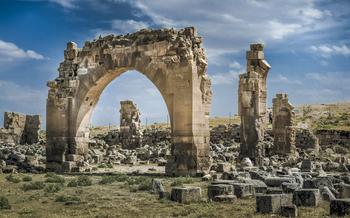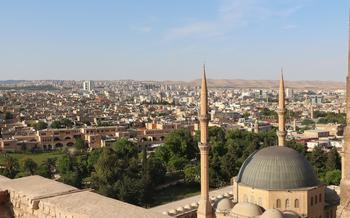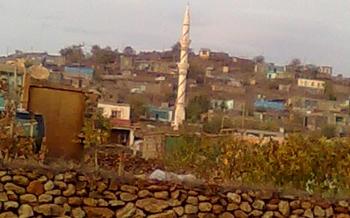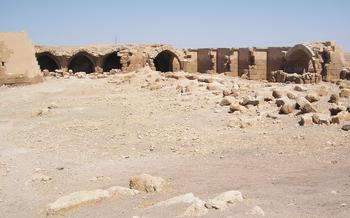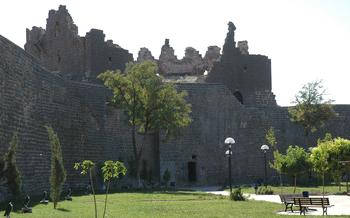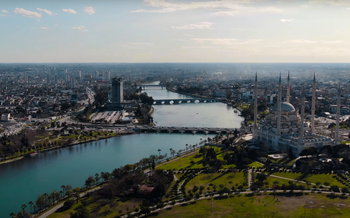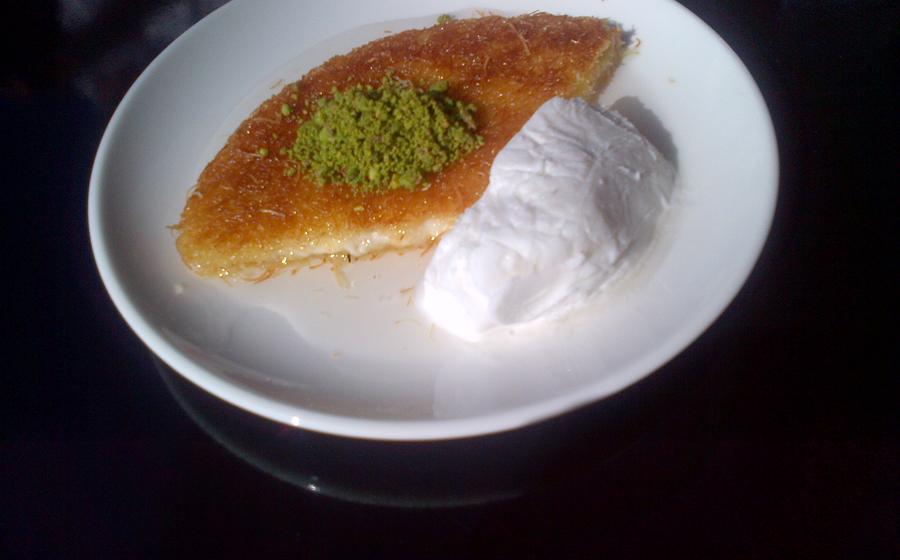
Traditional Urfa Houses
- Stepping Through the Threshold: Entering a Traditional Urfa House
- Courtyards: The Heart of the Traditional Urfa House
- Architecture: A Blend of History and Culture
- Rooms: A Glimpse into Daily Life
- Kitchens: Where Culinary Delights are Born
- Living Rooms: A Gathering Place for Family and Friends
- Bedrooms: A Sanctuary of Rest and Tranquility
- Bathrooms: A Blend of Tradition and Modernity
- Rooftops: A Panoramic Perspective
- Neighborhoods: A Tapestry of Community Life
- Preservation Efforts: Safeguarding a Legacy
- Transformation into Boutique Hotels: A New Lease on Life
- Visiting Tips: Making the Most of Your Experience
- Insider Tip: Unveiling the Hidden Treasures
Stepping Through the Threshold: Entering a Traditional Urfa House
As you cross the threshold of a traditional Urfa house, you are transported back in time, immersing yourself in the warmth and hospitality of Şanlıurfa's residents. The intricate details and vibrant colors that adorn the interiors captivate your senses, revealing the secrets hidden within the walls of these ancient homes.
The entrance to a traditional Urfa house is often adorned with intricate carvings and decorative elements, hinting at the treasures that lie within. Once inside, you are greeted by a spacious courtyard, the heart of the home. Here, the family gathers for meals, conversation, and relaxation, creating a sense of community and togetherness.
The rooms surrounding the courtyard are arranged in a symmetrical fashion, each serving a specific purpose. The guest room, often located near the entrance, is elegantly decorated and furnished, reflecting the importance of hospitality in Urfa culture. The living room, with its comfortable seating and vibrant carpets, invites you to unwind and engage in lively conversations.
As you explore the various rooms, you will discover hidden nooks and crannies, each with its own unique charm. The bedrooms, with their high ceilings and intricate wall paintings, offer a sanctuary of rest and tranquility. The kitchen, with its traditional wood-fired oven and array of copper pots and pans, is a testament to the culinary delights that are created within these walls.
Stepping through the threshold of a traditional Urfa house is not just a journey through space but also a journey through time and culture. It is an opportunity to experience the warmth and hospitality of the local people, to uncover the secrets of their traditions and customs, and to marvel at the beauty and craftsmanship of these historic dwellings.
Courtyards: The Heart of the Traditional Urfa House
The courtyards of traditional Urfa houses are their beating heart, serving as versatile spaces that adapt to various needs and activities. These central courtyards are enclosed by the house's surrounding rooms, creating a private and tranquil oasis within the bustling city. They have traditionally been used for a multitude of purposes, from cooking and dining to socializing and relaxing.
In the mornings, the courtyards come alive with the sounds of breakfast preparation as families gather to share a meal and plan their day. The aroma of freshly baked bread and sizzling eggs fills the air, creating a warm and inviting atmosphere. During the day, the courtyards transform into bustling workspaces, where women engage in traditional crafts such as weaving, embroidery, and pottery. The courtyards also serve as playgrounds for children, who run and play under the watchful eyes of their mothers.
As the sun begins to set, the courtyards become a venue for social gatherings and entertainment. Families and friends gather to share stories, sing songs, and play games. The courtyards are often adorned with colorful lanterns and candles, creating a magical and enchanting ambiance. The courtyards of traditional Urfa houses are not just physical spaces; they are also the heart and soul of the community, where memories are made, bonds are formed, and traditions are passed down from generation to generation.
Architecture: A Blend of History and Culture
The traditional houses of Şanlıurfa showcase a unique blend of architectural styles, reflecting the city's rich history and cultural influences. These dwellings often incorporate elements of Islamic, Byzantine, and Armenian architecture, creating a harmonious fusion of design and aesthetics.
Local materials such as stone, mud, and wood are predominantly used in the construction of these houses, ensuring their durability and adaptation to the local climate. Stone is commonly employed for foundations and exterior walls, providing strength and insulation. Mud bricks, made from a mixture of clay, straw, and water, are used to construct the upper floors, creating a cool and comfortable living environment. Wood is incorporated for doors, windows, and structural elements, adding warmth and character to the interiors.
The ingenious use of passive design strategies allows for effective temperature regulation within these traditional houses. Thick walls, small windows, and overhanging eaves provide shade and minimize heat gain during the scorching summer months. Courtyards, with their central water features and lush greenery, create a microclimate, further cooling the surrounding spaces.
The harmonious blend of functionality and aesthetics is evident in the architectural details of these houses. Intricate carvings, colorful tiles, and geometric patterns adorn the facades, showcasing the craftsmanship and artistry of local artisans. Arches, domes, and vaulted ceilings add a touch of grandeur and elegance to the interiors, creating visually stunning spaces.
Exploring the architectural heritage of Şanlıurfa's traditional houses offers a glimpse into the city's past, revealing the influences and ingenuity that have shaped their unique design.
Rooms: A Glimpse into Daily Life
The traditional Urfa house comprises various rooms, each serving a specific function and offering a glimpse into the daily life of the family. The most prominent room is the living room, where the family gathers for meals, social interactions, and entertainment. This room typically features intricate decorations, comfortable seating, and a central table. The bedrooms provide a sanctuary for rest and rejuvenation, with unique design elements and furnishings creating a serene atmosphere. The kitchen is the heart of the house, where culinary delights are prepared using traditional methods and utensils. Here, visitors can learn about the local cuisine and share a meal with a local family, experiencing the warmth and hospitality of Urfa's people.
Other rooms may include a guest room for hosting visitors, a storage room for keeping household items, and a bathroom that blends traditional features with modern amenities. Each room in a traditional Urfa house tells a story, reflecting the cultural heritage, customs, and traditions of this vibrant city.
Kitchens: Where Culinary Delights are Born
Immerse yourself in the vibrant atmosphere of traditional Urfa kitchens, where the magic of culinary delights unfolds. These kitchens are the heart of the home, where families gather to prepare and share delicious meals, creating memories that linger long after the dishes are cleared.
Discover the local cuisine of Şanlıurfa, a rich blend of flavors and aromas that has captivated taste buds for centuries. Learn about the unique cooking methods and utensils that have been passed down through generations, creating dishes that are both authentic and unforgettable.
Experience the warmth and hospitality of sharing a meal with a local family, as they welcome you into their home and share their culinary traditions. Savor the flavors of freshly baked bread, grilled meats, and aromatic stews, all prepared with love and care.
In these traditional kitchens, the preparation of food is not just a chore but a cherished ritual, where families bond and create lasting memories. The air is filled with the sounds of sizzling pans, the smell of spices, and the laughter of loved ones coming together to celebrate life's simple pleasures.
Living Rooms: A Gathering Place for Family and Friends
The living room, known as the "sofa" in traditional Urfa houses, holds a central place in family life. It serves as a gathering space where families come together to relax, bond, and entertain guests. The sofa is typically decorated with intricate patterns, colorful textiles, and comfortable furnishings, creating a warm and inviting atmosphere.
In traditional Urfa culture, hospitality is highly valued, and the sofa is often the setting for welcoming guests and visitors. Guests are greeted with warmth and offered refreshments, such as Turkish coffee or tea, while engaging in lively conversations and sharing stories. The sofa is also a place where families celebrate special occasions, host gatherings, and strengthen their bonds through shared experiences.
The living room's layout and design reflect the importance of family and community in Urfa culture. Seating arrangements are carefully arranged to encourage conversation and interaction, with low tables or coffee tables placed in the center to facilitate the sharing of food and drinks. The walls are often adorned with family portraits, artwork, and decorative items that reflect the family's history and heritage.
Stepping into the living room of a traditional Urfa house is like stepping into a warm embrace, where the essence of family, friendship, and hospitality come together to create a truly special and memorable experience.
Bedrooms: A Sanctuary of Rest and Tranquility
The bedrooms in traditional Urfa houses are private sanctuaries where families retreat for rest and rejuvenation. These intimate spaces exude a sense of tranquility and serenity, providing a refuge from the bustling city outside. The design elements and furnishings in the bedrooms are carefully chosen to create a calming and comfortable atmosphere.
Traditional Urfa bedrooms often feature simple yet elegant furnishings, such as low beds with intricate carvings, wooden wardrobes with colorful motifs, and colorful rugs that add warmth to the space. The use of natural materials, such as wood and cotton, creates a harmonious and inviting ambiance.
The cultural significance of the bedroom in traditional Urfa households is profound. It is a place where families gather to share stories, celebrate special occasions, and bond with each other. The privacy of the bedroom is highly respected, and it is considered a sacred space within the home.
Staying in a traditional Urfa bedroom offers a unique and immersive experience. The tranquility of these private spaces invites guests to unwind and relax, surrounded by the charm and history of these ancient dwellings.
Bathrooms: A Blend of Tradition and Modernity
In traditional Urfa houses, bathrooms hold a unique place, blending traditional practices with modern conveniences. While preserving their cultural heritage, these bathrooms have undergone a careful evolution to incorporate modern amenities.
Traditionally, bathrooms were simple spaces with a focus on functionality. Water was often drawn from a well or cistern and heated in a large copper pot called a "güğüm." Bathing rituals involved pouring water over the body and using natural soaps made from olive oil and lye.
Over time, modern plumbing systems were introduced, bringing running water and indoor showers. However, the traditional elements were not entirely abandoned. Many bathrooms still feature intricate tilework, marble accents, and copper fixtures, paying homage to the past.
The integration of modern amenities, such as water heaters, toilets, and sinks, has greatly improved the comfort and convenience of these spaces. Yet, the overall design and atmosphere often retain a sense of tradition and history.
By skillfully balancing cultural heritage with modern functionality, the bathrooms in traditional Urfa houses offer a unique experience that blends the charm of the past with the comforts of the present.
Rooftops: A Panoramic Perspective
Ascend to the rooftops of traditional Urfa houses and experience breathtaking views that stretch across the city, revealing a tapestry of architectural wonders and natural beauty. These elevated vantage points offer a unique perspective, allowing visitors to appreciate the grandeur of the city's skyline and the surrounding landscape. In the early morning light, rooftops come alive with the harmonious sounds of birdsong, creating a serene and tranquil atmosphere. As the sun sets, the sky transforms into a canvas of vibrant colors, casting a warm glow upon the city below.
Rooftops in traditional Urfa houses serve various cultural and practical functions. Traditionally, they were used as gathering places for families and friends to socialize, share stories, and enjoy the cool evening breeze. Today, they continue to be popular spots for relaxation and entertainment, offering a private oasis amidst the bustling city. Many rooftops are equipped with comfortable seating areas, inviting visitors to unwind and soak in the panoramic views.
In addition to their social significance, rooftops also played a practical role in traditional Urfa households. They were often used for drying laundry, taking advantage of the sun's natural heat and breeze. Residents would spread their freshly washed clothes on the rooftop, creating a colorful display that added to the charm of the city's skyline. Furthermore, rooftops served as storage spaces for food and other household items, providing a cool and airy environment to preserve their quality.
Today, rooftops in traditional Urfa houses continue to be an integral part of the city's architectural and cultural heritage. They offer visitors a unique opportunity to experience the city from a different perspective, appreciate its beauty, and connect with its rich traditions. Whether it's for relaxation, social gatherings, or simply taking in the stunning views, the rooftops of traditional Urfa houses provide a memorable and authentic experience.
Neighborhoods: A Tapestry of Community Life
The traditional Urfa houses are not merely isolated structures; they are woven into a vibrant tapestry of community life. The neighborhoods where these houses stand side by side are bustling centers of activity, where residents come together to share stories, celebrate traditions, and lend a helping hand to one another.
As you stroll through these neighborhoods, you'll be greeted by the warm smiles and friendly greetings of the locals. The air is filled with the sounds of laughter, children playing, and the enticing aromas of home-cooked meals wafting from the kitchens.
In the evenings, the neighborhoods transform into lively gathering places. Families and friends gather in the courtyards or on the rooftops to share stories, sip tea, and enjoy each other's company. The sound of music and laughter echoes through the streets, creating a joyous and convivial atmosphere.
The sense of community in these neighborhoods is palpable. Neighbors look out for one another, sharing joys and sorrows, and lending a helping hand whenever needed. It's a testament to the strong bonds that unite the people of Şanlıurfa and make these neighborhoods such special places to live and visit.
Preservation Efforts: Safeguarding a Legacy
The traditional Urfa houses are not merely architectural wonders; they are living testaments to a rich cultural heritage that needs to be preserved for future generations. Recognizing their significance, numerous initiatives and efforts have been undertaken to safeguard these historic dwellings. Local communities, organizations, and government bodies have joined forces to protect and restore these architectural treasures.
One of the key challenges in preserving traditional Urfa houses lies in balancing conservation with modernization. While it is essential to maintain the authenticity and integrity of these structures, it is also necessary to adapt them to contemporary living standards. This delicate balancing act requires careful planning, skilled craftsmanship, and a deep understanding of traditional construction techniques.
Preservation efforts often involve restoring dilapidated houses, repairing damaged elements, and implementing measures to prevent further deterioration. Local artisans and craftsmen play a crucial role in these endeavors, using traditional techniques and materials to ensure authenticity. In some cases, modern technologies and sustainable practices are incorporated to improve energy efficiency and overall functionality, while respecting the original character of the houses.
The preservation of traditional Urfa houses extends beyond physical restoration. It also involves documenting and archiving their history, stories, and architectural features. This knowledge is vital for future generations to understand and appreciate the cultural significance of these dwellings. Through research, publications, and educational programs, the legacy of these historic homes is passed on, ensuring their enduring relevance.
Transformation into Boutique Hotels: A New Lease on Life
In recent years, a growing number of traditional Urfa houses have been carefully restored and transformed into charming boutique hotels. These hotels offer a unique and immersive experience for travelers seeking an authentic taste of Şanlıurfa's history and culture.
Boutique hotels in traditional Urfa houses typically feature a limited number of rooms, each uniquely decorated with traditional furnishings and artifacts. Guests can enjoy the privacy and personalized service of a small hotel while still benefiting from modern amenities and conveniences.
Converting traditional houses into hotels presents several challenges. Architects and designers must carefully balance the need for modernization with the preservation of the building's original character. This often involves incorporating modern elements such as private bathrooms and air conditioning while respecting the traditional layout and architectural features.
Despite the challenges, the transformation of traditional Urfa houses into boutique hotels has been a resounding success. These hotels offer a unique and unforgettable experience for travelers, allowing them to immerse themselves in the city's rich history and culture while enjoying the comforts of modern hospitality.
Visiting Tips: Making the Most of Your Experience
To fully immerse yourself in the charm of Şanlıurfa's traditional houses, consider visiting during the shoulder seasons (spring and fall) when the weather is pleasant and the crowds are fewer. This will allow you to explore at a leisurely pace, savoring the unique details and stories embedded within each house.
Engage with the locals, who are always eager to share their culture and offer recommendations for hidden gems. Their insights can lead you to lesser-known houses or courtyards that might otherwise go unnoticed.
Respect the privacy of the residents and obtain permission before entering private homes. While most people are welcoming and happy to share their homes with visitors, it's important to be mindful of their privacy and seek their consent before entering.
Insider Tip: Unveiling the Hidden Treasures
Beyond the well-known attractions, Şanlıurfa holds a wealth of hidden treasures waiting to be discovered. Explore the secret courtyards and hidden gardens tucked away within traditional Urfa houses, offering a glimpse into the private lives of the city's residents. These hidden gems are often adorned with vibrant flowers, lush greenery, and intricate fountains, creating a tranquil oasis amidst the bustling city.
Delve into the local markets and bazaars, a vibrant tapestry of colors, sounds, and aromas. Discover unique souvenirs and handmade crafts that reflect the rich cultural heritage of the region. From intricate silver jewelry and colorful textiles to aromatic spices and traditional pottery, these markets offer a treasure trove of authentic finds.
Indulge in the delicious local cuisine, a culinary journey that will tantalize your taste buds. Savor the flavors and aromas of traditional dishes, such as the spicy kebabs, savory lahmacun, and the sweet künefe, a crispy pastry filled with melted cheese and pistachios.
Venture beyond the city center to explore the surrounding villages and countryside, where more hidden gems await. Discover ancient ruins, picturesque landscapes, and traditional villages that have preserved their charm and authenticity. Engage with the locals, learn about their way of life, and uncover the hidden stories that make Şanlıurfa a truly special destination.
